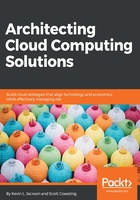
Application categories
The more value an application or business process can exploit from the basic cloud model value proposition, the more valuable a cloud transition becomes. This fact emphasizes the need to categorize enterprise applications by important organizational goals and target deployment options. Several factors can be used to categorize applications. This categorization often drives the selection of an appropriate deployment model for an application being moved to the cloud. These factors include security privacy regulation needs, unique technology requirements, agility, and elasticity needs. The process of categorizing applications is unique for each enterprise, but the cloud solution architect should educate, lead, and advise throughout the process:

Use of a categorization framework can form the basis for establishing a structured approach for assessing a given application's overall relative cloud migration value against the ease or difficulty in making that migration. It will also identify how valuable essential cloud characteristics are to the application's operational value:
In this example diagram, circle size represents overall cloud affinity. Cloud migration pain is affected by several factors, such as application dependencies, application cloud friendliness, associated security and compliance requirements, and other factors. The gain is derived from scalability, agility, elasticity, and overall organizational cloud transition motivation. Some of the most popular SaaS application categories are shown in the following table:

